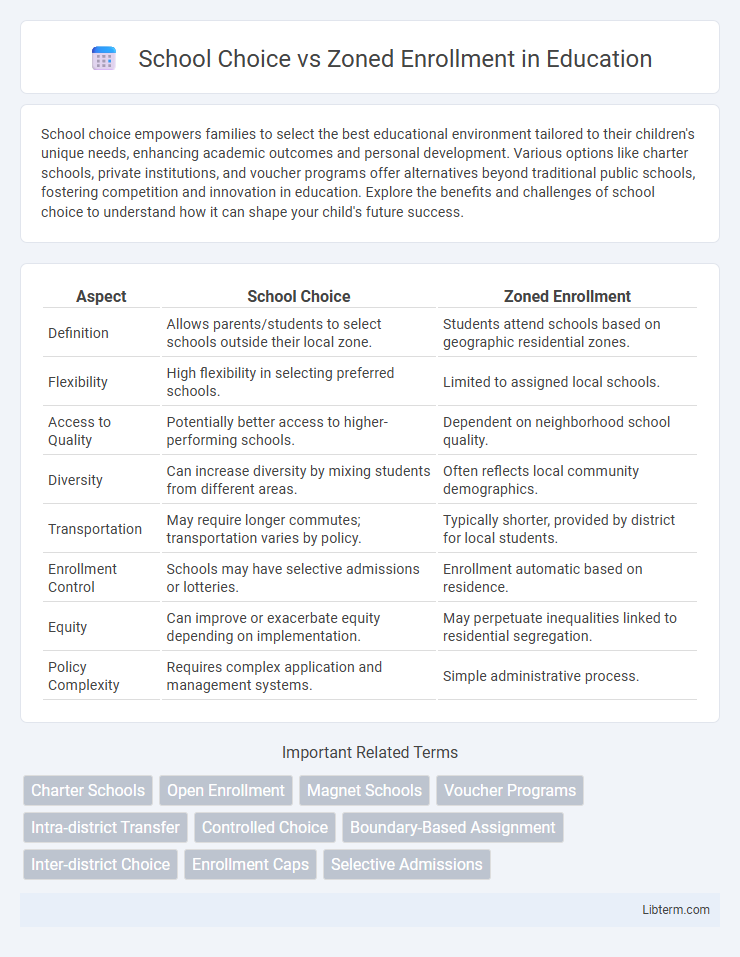School choice empowers families to select the best educational environment tailored to their children's unique needs, enhancing academic outcomes and personal development. Various options like charter schools, private institutions, and voucher programs offer alternatives beyond traditional public schools, fostering competition and innovation in education. Explore the benefits and challenges of school choice to understand how it can shape your child's future success.
Table of Comparison
| Aspect | School Choice | Zoned Enrollment |
|---|---|---|
| Definition | Allows parents/students to select schools outside their local zone. | Students attend schools based on geographic residential zones. |
| Flexibility | High flexibility in selecting preferred schools. | Limited to assigned local schools. |
| Access to Quality | Potentially better access to higher-performing schools. | Dependent on neighborhood school quality. |
| Diversity | Can increase diversity by mixing students from different areas. | Often reflects local community demographics. |
| Transportation | May require longer commutes; transportation varies by policy. | Typically shorter, provided by district for local students. |
| Enrollment Control | Schools may have selective admissions or lotteries. | Enrollment automatic based on residence. |
| Equity | Can improve or exacerbate equity depending on implementation. | May perpetuate inequalities linked to residential segregation. |
| Policy Complexity | Requires complex application and management systems. | Simple administrative process. |
Understanding School Choice: An Overview
School Choice allows families to select educational institutions based on preference rather than being confined to a specific geographic zone, promoting access to diverse curricula and specialized programs. This system often includes charter schools, magnet schools, and voucher-supported private schools, providing alternatives to traditional zoned enrollment. By enabling personalized education options, School Choice aims to improve student outcomes and satisfaction through increased competition and tailored learning environments.
What Is Zoned School Enrollment?
Zoned school enrollment assigns students to public schools based on their residential address within specific geographic boundaries, ensuring local access and community integration. This system promotes balanced resource distribution and manageable school capacities by linking enrollment to neighborhood zones. Parents seeking alternatives outside their assigned zones may pursue school choice options, which offer greater flexibility but can impact zoned schools' demographics and funding.
Historical Background of School Assignment
School assignment has historically been influenced by geographic zoning policies designed to allocate students to nearby public schools based on residential addresses, ensuring community-based schooling and resource distribution. The emergence of school choice arose as a reform movement in the late 20th century, aiming to provide families with alternatives beyond assigned neighborhood schools, often to promote educational equity and improve academic outcomes. Policy debates around historical school assignment highlight tensions between maintaining neighborhood school integrity and expanding access through choice programs, reflecting broader social and economic dynamics.
Key Benefits of School Choice
School choice empowers families by providing access to a broader range of educational options beyond their zoned schools, promoting personalized learning experiences tailored to individual student needs. It fosters competition among schools, driving improvements in quality, curriculum diversity, and innovative teaching methods. Enhanced parental involvement and the ability to select schools based on specialized programs or academic performance contribute to higher student engagement and achievement.
Advantages of Zoned Enrollment Systems
Zoned enrollment systems promote community cohesion by ensuring students attend schools within their local neighborhoods, fostering stronger family and school relationships. These systems enhance logistical convenience, reducing travel times and transportation costs for families and districts. Zoned enrollment also supports equitable resource distribution by balancing student populations according to geographic areas, helping to alleviate overcrowding and maintain manageable class sizes.
Equity Considerations in School Assignment
School Choice policies offer families the ability to select schools outside their residential zones, potentially increasing access to higher-quality education but often benefiting those with greater resources. Zoned Enrollment aims to ensure equitable access by assigning students based on geographic boundaries, promoting neighborhood school integration and reducing travel barriers. However, disparities in housing patterns and school funding can perpetuate inequities regardless of the assignment method, necessitating targeted measures to address systemic biases in educational opportunities.
Impact on Academic Outcomes
School choice programs often lead to improved academic outcomes by allowing students to attend higher-performing schools beyond their zoned boundaries, thereby promoting competition and innovation. Zoned enrollment can limit educational access, potentially perpetuating disparities in academic achievement due to variations in school quality tied to neighborhood demographics. Research indicates that students benefiting from school choice tend to have higher test scores and graduation rates compared to their peers restricted by zoned enrollment policies.
Community and Social Implications
School choice policies often lead to increased segregation and diminished neighborhood cohesion as families select schools outside their local zones, disrupting local social networks and community identity. Zoned enrollment fosters stronger community ties by ensuring children attend neighborhood schools, promoting shared experiences and interactions among residents. However, strict zones can limit diversity and perpetuate educational inequalities based on residential segregation patterns.
Policy Challenges and Controversies
School choice policies face significant challenges related to equity and resource allocation, often intensifying disparities between affluent and low-income communities. Zoned enrollment systems aim to promote neighborhood cohesion but can reinforce segregation and limit access to high-quality education for marginalized students. Policymakers must balance these competing interests while addressing concerns about racial segregation, funding inequalities, and parental autonomy in education decisions.
Future Trends in Education Enrollment
School choice is reshaping education enrollment by increasing demand for charter schools, magnet programs, and voucher systems, thereby reducing reliance on traditional zoned enrollment based on geographic boundaries. Advances in data analytics and personalized learning platforms are enabling parents and students to select schools that better align with their academic needs and career goals, promoting a more student-centered approach. Future trends indicate a growing emphasis on hybrid enrollment models, combining online and in-person options, which will further diversify educational access and challenge the conventional zoned attendance zones.
School Choice Infographic

 libterm.com
libterm.com